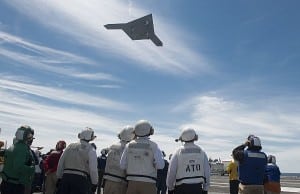
Companies in the running for the Navy’s future aircraft carrier-launched unmanned vehicle program believe they’ll be able to effectively compete against rival Northrop Grumman [NOC] even though the firm has benefited from being the lead contractor on the demonstrator program. Executives from Boeing [BA] and Lockheed Martin [LMT] have said they are satisfied the Navy is adequately sharing information with them about the X-47B demonstrator that made history last year by launching from an aircraft carrier and performing an arresting…













